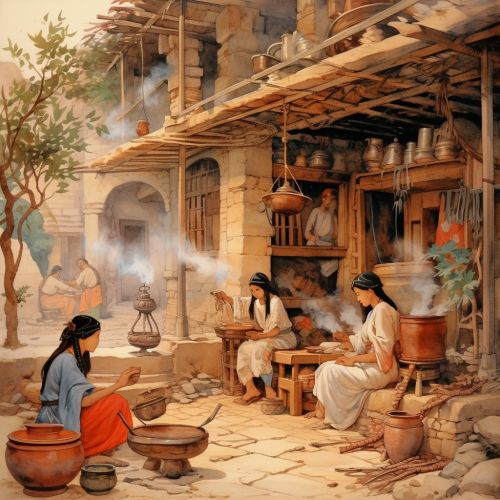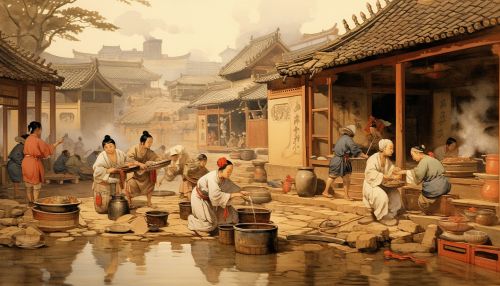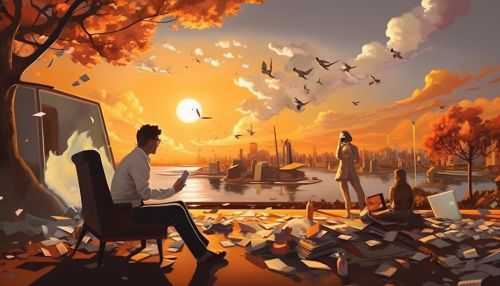Illustration
Overview
Illustration is a visual representation or decoration used to elucidate or decorate a text, concept, or process. It is a form of visual communication and artistic expression that plays a significant role in various fields, including publishing, advertising, and design. The term "illustration" is derived from the Latin word "illustra'tio", which means "enlightenment" or "clarification". Visual communication is a critical aspect of illustration, as it uses images to convey ideas and messages.
History
The history of illustration can be traced back to prehistoric times, with the earliest examples found in cave paintings and petroglyphs. These early forms of illustration were primarily used to depict daily life, hunting scenes, and religious rituals. With the advent of written language, illustrations began to be used to supplement and enhance written text. In ancient Egypt, for example, hieroglyphics combined text and illustration to convey complex ideas and stories.


During the Middle Ages, illustrations were predominantly used in religious texts. Illuminated manuscripts, such as the Book of Kells, featured elaborate illustrations that were often gilded with gold or silver. These illustrations not only enhanced the aesthetic appeal of the manuscripts but also helped convey religious messages and stories.
The invention of the printing press in the 15th century revolutionized the field of illustration. Woodcut illustrations became common in printed books, and the profession of the illustrator became more established. During the 19th century, advancements in printing technology, such as lithography and chromolithography, allowed for the production of illustrations in color.
In the 20th century, the rise of mass media and advertising led to a significant increase in the demand for illustrations. Illustrators began to work in a variety of new mediums, including film, television, and digital media. Today, illustration is a diverse field that encompasses a wide range of styles and techniques.
Types of Illustration
There are many different types of illustration, each with its own unique characteristics and applications. Some of the most common types include:
Editorial Illustration
Editorial illustrations are used in newspapers, magazines, and online publications to accompany articles and op-eds. They help to visually represent the content of the article and engage the reader's attention. Editorial illustrations can range from simple line drawings to complex digital artworks.
Book Illustration
Book illustrations are used to enhance the text of a book, either by adding visual interest or by helping to explain complex ideas or concepts. They can be found in a variety of books, including children's books, textbooks, and graphic novels.
Advertising Illustration
Advertising illustrations are used in print and digital advertisements to promote products or services. They can be used to create a mood, tell a story, or evoke a specific response from the viewer.
Scientific Illustration
Scientific illustrations are used in scientific publications and textbooks to visually represent scientific concepts and data. They are often highly detailed and accurate, and may include diagrams, charts, and other visual aids.
Concept Art
Concept art is a type of illustration used in the film, video game, and animation industries to visualize ideas and concepts before they are brought to life. Concept artists create illustrations of characters, environments, and props to guide the production process.
Techniques
Illustration techniques vary widely depending on the medium and the illustrator's personal style. Some illustrators prefer traditional mediums, such as pencil, ink, watercolor, or oil paint, while others work digitally using software like Adobe Illustrator or Photoshop.
Traditional Techniques
Traditional illustration techniques involve the use of physical materials and tools. Some of the most common traditional techniques include:
Drawing
Drawing is one of the most fundamental illustration techniques. It involves the use of pencils, pens, charcoal, or other drawing tools to create an image on a surface. Drawing can be used to create detailed line work, shading, and texture.
Painting
Painting involves the application of pigment to a surface using a brush or other tool. There are many different types of painting techniques, including oil painting, watercolor painting, and acrylic painting.
Printmaking
Printmaking involves creating an image on a matrix (such as a block, plate, or screen) and transferring it to a surface (usually paper) using ink. There are many different types of printmaking techniques, including woodcut, etching, lithography, and screen printing.
Digital Techniques
Digital illustration techniques involve the use of computer software and hardware. Some of the most common digital techniques include:
Vector Illustration
Vector illustration involves the use of vector graphics software, such as Adobe Illustrator, to create images composed of paths and shapes. Vector illustrations are scalable without loss of quality, making them ideal for logos and other designs that need to be resized frequently.
Digital Painting
Digital painting involves the use of software that simulates traditional painting techniques. Digital painters use a stylus and drawing tablet to create images on a computer.
3D Modeling
3D modeling involves the use of software to create a three-dimensional representation of an object or scene. 3D models can be used to create realistic or stylized illustrations, and can be rendered with different lighting and texture effects.
Role and Impact
Illustration plays a crucial role in various industries and fields. In publishing, illustrations enhance the reader's understanding and enjoyment of a text. In advertising, illustrations can help to sell a product or service by creating a memorable image or concept. In education, illustrations can help to explain complex ideas and concepts in a visual and accessible way.
Illustrations also have a significant cultural impact. They can reflect societal trends and attitudes, and can be a powerful tool for social commentary and criticism. Many illustrators use their work to express their personal views and ideas, and to engage with contemporary issues and debates.


Future Trends
The field of illustration is constantly evolving, with new trends and technologies emerging all the time. Some of the key trends shaping the future of illustration include:
Digital Illustration
The use of digital tools and software in illustration is becoming increasingly common. Digital illustration offers a range of benefits, including the ability to easily edit and revise work, the ability to work in a variety of styles and mediums, and the ability to share and distribute work online.
Motion Graphics
Motion graphics involve the use of animation and video techniques to create moving illustrations. This form of illustration is becoming increasingly popular in advertising and digital media.
Augmented Reality (AR) and Virtual Reality (VR)
AR and VR technologies are opening up new possibilities for illustration. These technologies allow illustrators to create immersive and interactive experiences, and to explore new forms of visual storytelling.
